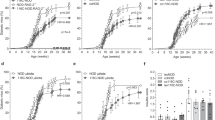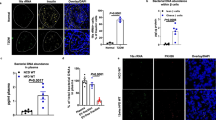Abstract
Type 1 diabetes (T1D) is a debilitating autoimmune disease that results from T-cell-mediated destruction of insulin-producing β-cells. Its incidence has increased during the past several decades in developed countries1,2, suggesting that changes in the environment (including the human microbial environment) may influence disease pathogenesis. The incidence of spontaneous T1D in non-obese diabetic (NOD) mice can be affected by the microbial environment in the animal housing facility3 or by exposure to microbial stimuli, such as injection with mycobacteria or various microbial products4,5. Here we show that specific pathogen-free NOD mice lacking MyD88 protein (an adaptor for multiple innate immune receptors that recognize microbial stimuli) do not develop T1D. The effect is dependent on commensal microbes because germ-free MyD88-negative NOD mice develop robust diabetes, whereas colonization of these germ-free MyD88-negative NOD mice with a defined microbial consortium (representing bacterial phyla normally present in human gut) attenuates T1D. We also find that MyD88 deficiency changes the composition of the distal gut microbiota, and that exposure to the microbiota of specific pathogen-free MyD88-negative NOD donors attenuates T1D in germ-free NOD recipients. Together, these findings indicate that interaction of the intestinal microbes with the innate immune system is a critical epigenetic factor modifying T1D predisposition.
This is a preview of subscription content, access via your institution
Access options
Subscribe to this journal
Receive 51 print issues and online access
$199.00 per year
only $3.90 per issue
Buy this article
- Purchase on SpringerLink
- Instant access to full article PDF
Prices may be subject to local taxes which are calculated during checkout




Similar content being viewed by others
References
Karvonen, M., Tuomilehto, J., Libman, I. & LaPorte, R. A review of the recent epidemiological data on the worldwide incidence of type 1 (insulin-dependent) diabetes mellitus. World Health Organization DIAMOND Project Group. Diabetologia 36, 883–892 (1993)
Patterson, C. C., Dahlquist, G., Soltesz, G. & Green, A. Is childhood-onset type I diabetes a wealth-related disease? An ecological analysis of European incidence rates. Diabetologia 44 (suppl. 3). B9–B16 (2001)
Pozzilli, P., Signore, A., Williams, A. J. & Beales, P. E. NOD mouse colonies around the world–recent facts and figures. Immunol. Today 14, 193–196 (1993)
McInerney, M. F., Pek, S. B. & Thomas, D. W. Prevention of insulitis and diabetes onset by treatment with complete Freund’s adjuvant in NOD mice. Diabetes 40, 715–725 (1991)
Sadelain, M. W., Qin, H. Y., Lauzon, J. & Singh, B. Prevention of type I diabetes in NOD mice by adjuvant immunotherapy. Diabetes 39, 583–589 (1990)
Janeway, C. A. Approaching the asymptote? Evolution and revolution in immunology. Cold Spring Harb. Symp. Quant. Biol. 54, 1–13 (1989)
Akira, S., Uematsu, S. & Takeuchi, O. Pathogen recognition and innate immunity. Cell 124, 783–801 (2006)
Rakoff-Nahoum, S., Paglino, J., Eslami-Varzaneh, F., Edberg, S. & Medzhitov, R. Recognition of commensal microflora by Toll-like receptors is required for intestinal homeostasis. Cell 118, 229–241 (2004)
Strober, W. Epithelial cells pay a Toll for protection. Nature Med. 10, 898–900 (2004)
Wong, F. S. et al. Identification of an MHC class I-restricted autoantigen in type 1 diabetes by screening an organ-specific cDNA library. Nature Med. 5, 1026–1031 (1999)
Graser, R. T. et al. Identification of a CD8 T cell that can independently mediate autoimmune diabetes development in the complete absence of CD4 T cell helper functions. J. Immunol. 164, 3913–3918 (2000)
Amrani, A. et al. Perforin-independent beta-cell destruction by diabetogenic CD8+ T lymphocytes in transgenic nonobese diabetic mice. J. Clin. Invest. 103, 1201–1209 (1999)
Haskins, K. & McDuffie, M. Acceleration of diabetes in young NOD mice with a CD4+ islet-specific T cell clone. Science 249, 1433–1436 (1990)
Lieberman, S. M. et al. Individual nonobese diabetic mice exhibit unique patterns of CD8+ T cell reactivity to three islet antigens, including the newly identified widely expressed dystrophia myotonica kinase. J. Immunol. 173, 6727–6734 (2004)
Lieberman, S. M. et al. Identification of the beta cell antigen targeted by a prevalent population of pathogenic CD8+ T cells in autoimmune diabetes. Proc. Natl Acad. Sci. USA 100, 8384–8388 (2003)
Hoglund, P. et al. Initiation of autoimmune diabetes by developmentally regulated presentation of islet cell antigens in the pancreatic lymph nodes. J. Exp. Med. 189, 331–339 (1999)
Turley, S. J., Lee, J. W., Dutton-Swain, N., Mathis, D. & Benoist, C. Endocrine self and gut non-self intersect in the pancreatic lymph nodes. Proc. Natl Acad. Sci. USA 102, 17729–17733 (2005)
Suzuki, T. et al. in Immune-deficient Animals in Biomedical Research (eds Rygaard, J. B. N., Graem, N. & Spang-Thomsen, M.) 112–116 (Karger, 1985)
Gray, D. H., Gavanescu, I., Benoist, C. & Mathis, D. Danger-free autoimmune disease in Aire-deficient mice. Proc. Natl Acad. Sci. USA 104, 18193–18198 (2007)
Kim, H. S. et al. Toll-like receptor 2 senses beta-cell death and contributes to the initiation of autoimmune diabetes. Immunity 27, 321–333 (2007)
Dewhirst, F. E. et al. Phylogeny of the defined murine microbiota: altered Schaedler flora. Appl. Environ. Microbiol. 65, 3287–3292 (1999)
Ley, R. E. et al. Obesity alters gut microbial ecology. Proc. Natl Acad. Sci. USA 102, 11070–11075 (2005)
Ley, R. E., Turnbaugh, P. J., Klein, S. & Gordon, J. I. Microbial ecology: human gut microbes associated with obesity. Nature 444, 1022–1023 (2006)
Rawls, J. F., Mahowald, M. A., Ley, R. E. & Gordon, J. I. Reciprocal gut microbiota transplants from zebrafish and mice to germ-free recipients reveal host habitat selection. Cell 127, 423–433 (2006)
Ley, R. E., Peterson, D. A. & Gordon, J. I. Ecological and evolutionary forces shaping microbial diversity in the human intestine. Cell 124, 837–848 (2006)
Turnbaugh, P. J. et al. An obesity-associated gut microbiome with increased capacity for energy harvest. Nature 444, 1027–1031 (2006)
Turnbaugh, P. J., Backhed, F., Fulton, L. & Gordon, J. I. Diet-induced obesity is linked to marked but reversible alterations in the mouse distal gut microbiome. Cell Host Microbe 3, 213–223 (2008)
Funda, D. P., Fundova, P. & Harrison, L. C. Microflora-dependency of selected diabetes-preventive diets: germ-free and ex-germ-free monocolonized NOD mice as models for studying environmental factors in type 1 diabetes. Proc. 13th Int. Congr. Immunol. MS-11.4 16 (Brazilian Society for Immunology, Rio de Janeiro, 2007)
Wang, Q., Garrity, G. M., Tiedje, J. M. & Cole, J. R. Naive Bayesian classifier for rapid assignment of rRNA sequences into the new bacterial taxonomy. Appl. Environ. Microbiol. 73, 5261–5267 (2007)
Calcinaro, F. et al. Oral probiotic administration induces interleukin-10 production and prevents spontaneous autoimmune diabetes in the non-obese diabetic mouse. Diabetologia 48, 1565–1575 (2005)
Huber, T., Faulkner, G. & Hugenholtz, P. Bellerophon: a program to detect chimeric sequences in multiple sequence alignments. Bioinformatics 20, 2317–2319 (2004)
Petkov, P. M. et al. An efficient SNP system for mouse genome scanning and elucidating strain relationships. Genome Res. 14, 1806–1811 (2004)
Kanagawa, O., Militech, A. & Vaupel, B. A. Regulation of diabetes development by regulatory T cells in pancreatic islet antigen-specific TCR transgenic nonobese diabetic mice. J. Immunol. 168, 6159–6164 (2002)
Takaki, T. et al. Requirement for both H-2Db and H-2Kd for the induction of diabetes by the promiscuous CD8+ T cell clonotype AI4. J. Immunol. 173, 2530–2541 (2004)
Stratmann, T. et al. Susceptible MHC alleles, not background genes, select an autoimmune T cell reactivity. J. Clin. Invest. 112, 902–914 (2003)
Dojka, M. A., Hugenholtz, P., Haack, S. K. & Pace, N. R. Microbial diversity in a hydrocarbon- and chlorinated-solvent-contaminated aquifer undergoing intrinsic bioremediation. Appl. Environ. Microbiol. 64, 3869–3877 (1998)
Weisburg, W. G., Barns, S. M., Pelletier, D. A. & Lane, D. J. 16S ribosomal DNA amplification for phylogenetic study. J. Bacteriol. 173, 697–703 (1991)
Ludwig, W. et al. ARB: a software environment for sequence data. Nucleic Acids Res. 32, 1363–1371 (2004)
Lozupone, C. & Knight, R. UniFrac: a new phylogenetic method for comparing microbial communities. Appl. Environ. Microbiol. 71, 8228–8235 (2005)
Lozupone, C., Hamady, M. & Knight, R. UniFrac—an online tool for comparing microbial community diversity in a phylogenetic context. BMC Bioinformatics 7, 371 (2006)
Acknowledgements
The authors are thankful to A. Putnam, T. Park, D. Schumann, M. Prokhorovich, W. Du, D. O’Donnell, M. Karlsson and S. Wagoner for help with experiments, and S. Dryden Perkins and M. Garcia for assistance with sequence analysis. This work was supported by the ADA grant 1-05-RA-142 to L.W.; JDRF grant 19-2006-1075 to L.W. and F.S.W.; Animal Genetic Core of Diabetes Endocrinology Research Center (NIH grant DK45735) to L.W.; NIH grants R37 AI46643 and P30 DK63720 as well as the JDRF 4-2005-1168 grant to J.A.B.; NIH grants DK30292 and DK70977, and a W. M. Keck Foundation award to J.I.G.; NIH grant DK063452 to A.V.C.; JDRF grants 2005-204 and 2007-353 to A.V.C.; and the NIH/NIDDK Digestive Disease Research Core Center grant DK42086.
Author Contributions L.W. designed and supervised experiments at Yale University; R.E.L. performed analysis of 16S rRNA sequences of the gut microbiota; P.Yu.V. analysed T1D development in germ-free and microbiota-colonized mice; P.B.S. performed ELISPOT analysis; L.A. and A.C.S. established and characterized mutant mouse strains at The Jackson Laboratory and at The University of Chicago; C.H., F.S.W. and L.W. characterized mutant mouse strains at Yale University; G.L.S. was involved in performance of regulatory-T-cell-based assays; J.A.B. designed and supervised the T cell assays; J.I.G. helped with design and interpretation of gut microbial ecology studies and oversaw the microbiota transfer experiments; A.V.C. conceived and designed the project, and wrote the manuscript with substantial critical contributions from L.W., R.E.L., F.S.W., J.A.B. and J.I.G.
Author information
Authors and Affiliations
Corresponding author
Supplementary information
Supplementary Information
This file contains Supplementary Results with additional references, Supplementary Figures 1-8 with Legends. (PDF 10475 kb)
Rights and permissions
About this article
Cite this article
Wen, L., Ley, R., Volchkov, P. et al. Innate immunity and intestinal microbiota in the development of Type 1 diabetes. Nature 455, 1109–1113 (2008). https://doi.org/10.1038/nature07336
Received:
Accepted:
Published:
Issue Date:
DOI: https://doi.org/10.1038/nature07336
This article is cited by
-
Age-, sex- and proximal–distal-resolved multi-omics identifies regulators of intestinal aging in non-human primates
Nature Aging (2024)
-
B-Glycine as a marker for β cell imaging and β cell mass evaluation
European Journal of Nuclear Medicine and Molecular Imaging (2024)
-
Pathobionts from chemically disrupted gut microbiota induce insulin-dependent diabetes in mice
Microbiome (2023)
-
Feature selection of the respiratory microbiota associated with asthma
Journal of Big Data (2023)
-
Microbiome and pregnancy: focus on microbial dysbiosis coupled with maternal obesity
International Journal of Obesity (2023)



